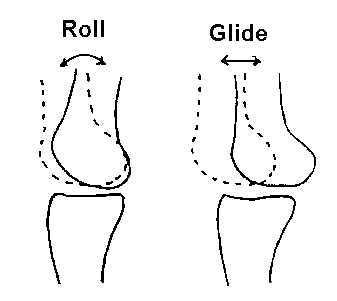The figure, a sagittal plane depiction of the knee (tibio-femoral) joint, illustrates roll, like the rolling of a tire on a surface, and glide, like a tire slipping without rolling.


We speak as if this joint axis is a fixed point, as if the center of rotation is stationary like an automobile axle. Joint axes' locations are fairly stable, but only because the joint surfaces move in a very specific way.
ARTHROKINEMATICS is the general term for the specific movements of joint surfaces. Normal joint surface movement is necessary to ensure long-term joint integrity. (Joint surface movements are sometimes called joint play motions or component motions).
Joint surfaces move with respect to one another by simultaneously (1) rolling, (2) gliding, and (3) spinning. This discussion focuses on how joint surfaces roll and glide with respect to one another, and largely ignores the spin component.
The figure, a sagittal plane depiction of the knee (tibio-femoral) joint, illustrates roll, like the rolling of a tire on a surface, and glide, like a tire slipping without rolling.

|
|---|
If the moving joint surface rolls on its partner without simultaneously gliding, the surfaces would separate (gap or subluxate) in some places and impinge in others. Roll and glide must occur simultaneously to preserve joint integrity. We can predict and understand the relationship between bony shapes at a joint surface and the surfaces' movements by applying the rules of concavity and convexity (Kaltenborn 1989, p.27).
NB: Roll and glide do not occur in the direction they do because of the shape of the joint surfaces. Roll and glide, like all motions, are produced by forces.
Movements at joint surfaces (arthrokinematics) follow the rules of concavity and convexity.Each joint or articulation involves two bony surfaces, one that is convex and one that is concave. | 
|
|---|
When the concave surface is fixed and the convex surface moves on it, the convex surface rolls and glides in opposite directions.

The figure illustrates how joint subluxation or dislocation would result were a convex surface to roll on a fixed concave surface without gliding at the same time. To preserve joint integrity, roll and glide must occur simultaneously, and must occur in opposite directions. In this example, the convex joint surface must roll posteriorly (curved arrow) and glide anteriorly (straight arrow). | |||
|---|---|---|---|
When the convex surface is fixed and the concave surface moves on it, the concave surface rolls and glides in the same direction.

The figure illustrates how joint surfaces would gap in some areas and impinge in others were a concave surface to roll on a fixed convex surface without gliding at the same time. To preserve joint integrity, roll and glide must occur simultaneously, and in the same direction. In this example, the concave joint surface must roll posteriorly (curved arrow) and glide posteriorly (straight arrow). | |||
|---|---|---|---|